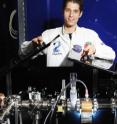Eindhoven University builds affordable alternative to mega-laser X-FEL
FEL (X-ray Free Electron Laser) with a pricetag of hundreds of millions. It provides images of 'molecules in action', using a kilometer-long electron accelerator. Researchers at Eindhoven University of Technology (TU/e) have developed an alternative that can do many of the same things. However this alternative fits on a tabletop, and costs around half a million euro. That's why the researchers have jokingly called it 'the poor man's X-FEL'. It's one of the few remaining 'holy grails' of science: a system that allows you to observe the extremely high-speed molecular processes at an atomic scale. You could call it an ultra-fast video microscope. Instead of visible light this kind of system uses X-rays or electrons, because it requires radiation with a wavelength of less than a nanometer. The X-rays or electrons have to be emitted in ultra short pulses, so that the exposure time is extremely short. However these pulses are not easy to generate. An X FEL uses X-ray pulses for this purpose, generated by accelerating electrons in an accelerator of a kilometer, or longer. These electrons are then converted into X-rays. An installation of this kind is very costly, uses large amounts of energy and needs a whole team to operate it. A European X-FEL, which will cost a billion euro, is currently under construction in Hamburg (Germany).
One centimeter
TU/e doctoral candidate ir. Thijs van Oudheusden (Department of Applied Physics) has developed a machine that in many respects can compete with this billion-euro facility, based on ideas from his co supervisor dr.ir. Jom Luiten. The essence of their 'poor man's X-FEL' is that it uses electrons instead of X-rays. "Why convert electrons into X-rays if you can use the electrons themselves?", asks Van Oudheusden. "As well as that you only need to give the electrons a low energy, so you can accelerate them in just a centimeter. That's why the whole system fits on a tabletop."
Just one shot
The physical barrier that Van Oudheusden had to overcome is that the electrons in electron bunches repel each other. This causes the electron bunches to expand, making them longer than the desired 100 femtoseconds (1 femtosecond is 10-15 second), which in turn would make the 'video microscope' too slow. Jom Luiten thought of a solution to prevent the undesired expansion. The key was to create bunches of exactly the right shape, so they can be controlled and focused by means of electrical fields into bunches of the desired type and length. All with a number of electrons (1 million) that is sufficient to create a diffraction pattern in just a single shot.
In users' own labs
Supervisor prof.dr. Marnix van der Wiel believes that half to three-quarters of the kind of research that can be done on an X-FEL can also be done with the 'poor man's X_FEL'. But this doesn't immediately mean that the latter is automatically a lot cheaper in relation to the scientific output that can be generated with it. "The X-FEL at Stanford works non-stop, all year round, and is used by thousands of research groups over several decades. So if you're allocated time on the system you have to take all your equipment to the USA, where you have to stick to a very strict schedule. Our finding is a good alternative for people who want to have the freedom to do research in their own labs. As far as the costs are concerned, it depends on the user if our system will turn out to be cheaper on a per publication basis."
Half a million
TU/e spin-off AccTec BV intends to build the machine developed by Van Oudheusden and Luiten and to sell it to scientific users. AccTec expects the total price to be below half a million euro.
Thijs van Oudheusden gained his PhD on 13 December with his doctoral thesis entitled 'Electron source for sub-relativistic single-shot femtosecond diffraction'. His research received financial support from the Stichting voor Fundamenteel Onderzoek der Materie (Foundation for Fundamental Research on Matter – FOM).
Source: Eindhoven University of Technology
Other sources
- Dutch researchers build affordable alternative to mega-laser X-FELfrom PhysorgWed, 22 Dec 2010, 16:31:09 UTC
- Eindhoven University builds affordable alternative to mega-laser X-FELfrom Science BlogWed, 22 Dec 2010, 16:30:37 UTC
